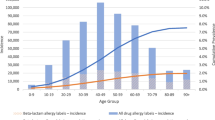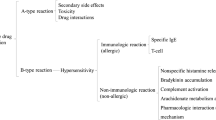Abstract
Purposes of review
In order to introduce the advances and use of the new sub-section addressed to the drug hypersensitivity reactions (DHRs) in the World Health Organizations’ International Classification of Diseases (ICD)-11 revision, we here proposed a used case document and discuss the perspective of this new framework.
Recent findings
We expect that the construction of the new section addressed to DHRs in the ICD-11 will allow the collection of more accurate epidemiological data to support quality management of patients with drug allergies, and better facilitate health care planning to implement public health measures to prevent and reduce the morbidity and mortality attributable to DHRs.
Summary
Allergy and hypersensitivity reactions, including DHRs, have never been well classified in the World Health Organization’s (WHO) ICD. The ALLERGY in ICD-11 initiative was launched 6 years ago to have a better representation of these disorders in the ongoing 11th revision of the ICD. It has been supported by six major international allergy academies, and collaboration with the WHO has been established and is ongoing so far. This document intends to present advances and use of the new “Drug hypersensitivity” section of the ICD-11.


Similar content being viewed by others
Abbreviations
- DHR:
-
drug hypersensitivity reaction
- ENT:
-
ear, nose, throat
- ICD:
-
International Classification of Diseases
- NSAIDs:
-
non-steroidal anti-inflammatory drugs
- PM:
-
precision medicine
- WHO:
-
World Health Organization
References and recommended reading
Papers of particular interest, published recently, have been highlighted as: • Of importance, •• Of major importance
• World Health Organization, International Classification of Diseases website. (cited, available: http://www.who.int/classifications/icd/en/accessed October 2017.) Introduces general aims and purposes of the World Health Organization classification system.
Tanno LK, Calderon MA, Goldberg BJ, Akdis CA, Papadopoulos NG, Demoly P. Categorization of allergic disorders in the new World Health Organization International Classification of Diseases. Clin Transl Allergy. 2014;4:42.
Castells M. Drug hypersensitivity and desensitization. Immunol Allergy Clin. 37(4):xvii–xviii. in press
Davies DM, Ashton CH, Rao JG, Rawlins MD, Routledge PA, Savage RL, et al. Comprehensive clinical drug information service: first year’s experience. Br Med J. 1977;1:89–90.
Lugardon S, Desboeuf K, Fernet P, et al. Using a capture–recapture method to assess the frequency of adverse drug reactions in a French university hospital. Br J Clin Pharmacol. 2006;62:225–31.
•• Joint Task Force on Practice Parameters; American Academy of Allergy AaIACoA, Asthma and Immunology; Joint Council of Allergy, Asthma and Immunology. Drug allergy: an updated practice parameter. Ann Allergy Asthma Immunol. 2010;105:259–73. American experts practice parameters regarding drug allergy.
Tanno LK, Ganem F, Demoly P, Toscano CM, Bierrenbach AL. Undernotification of anaphylaxis deaths in Brazil due to difficult coding under the ICD-10. Allergy. 2012;67:783–9.
•• Tanno LK, Bierrenbach AL, Calderon MA, Sheikh A, Simons FE, Demoly P. Joint Allergy Academies. Decreasing the undernotification of anaphylaxis deaths in Brazil through the International Classification of Diseases (ICD)-11 revision. Allergy. 2017;72(1):120–125.xProves the usability and accuracy of the International Classification of Diseases 11 for anaphylaxis mortality statistics.
Moneret-Vautrin DA, Morisset M, Flabbee J, et al. Epidemiology of life-threatening and lethal anaphylaxis: a review. Allergy. 2005;60:443–51.
• WHO. International drug monitoring: the role of national centres. Report of a WHO meeting. Tech Rep Ser WHO. 1972;498:1–25. World Health Organization’s pharmacovigilance activities.
•• Johansson SG, Bieber T, Dahl R, Friedmann PS, Lanier BQ, Lockey RF, et al. Revised nomenclature for allergy for global use: Report of the Nomenclature Review Committee of the World Allergy Organization, October 2003. J Allergy Clin Immunol. 2004;113:832–6. Key document in the field of allergies classification.
•• Demoly P, Adkinson NF, Brockow K, Castells M, Chiriac AM, Greenberger PA, et al. Thong BYH. International consensus on drug allergy. Allergy. 2014;69:420–37. International consensus document regarding drug allergy.
• Kowalski ML, Makowska JS, Blanca M, Bavbek S, Bochenek G, Bousquet J, et al. Hypersensitivity to nonsteroidal anti-inflammatory drugs (NSAIDs)—classification, diagnosis and management: review of the EAACI/ENDA# and GA2LEN/HANNA. Allergy. 2011;66:818–29. Key document in the field of classification of hypersensitivity of nonsteroidal anti-inflammatory drugs.
Cousin M, Chiriac A, Molinari N, Demoly P, Caimmi D. Phenotypical characterization of children with hypersensitivity reactions to NSAIDs. Pediatr Allergy Immunol. 2016;27(7):743–8.
Widal MF, Abrami P, Lermoyez J. Anaphylaxie et idiosyncrasie. Presse Med. 1922;30:189–92.
Samter M, Beers RF. Intolerance to aspirin: clinical studies and consideration of its pathogenesis. Ann Intern Med. 1968;68:975–83.
World Health Organization, ICD-10 version 2016 website. (cited, available: http://apps.who.int/classifications/icd10/browse/2016/en accessed October 2017).
•• Tanno LK, Calderon MA, Demoly P, on behalf the Joint Allergy Academies. New allergic and hypersensitivity conditions section in the International Classification of Diseases-11. Allergy Asthma Immunol Res. 2016;8(4):383–8. https://doi.org/10.4168/aair.2016.8.4.383. Introduced the first section addressed to allergic and hypersensitivity reaction in the history of the International Classification of Diseases
Tanno LK, Sublett JL, Meadows JA, Calderon M, Gross GN, Casale T, et al. Perspectives of the International Classification of Diseases (ICD)-11 in allergy clinical practice in the United States of America. Ann Allergy Asthma Immunol. 2017;118(2):127–32.
Demoly P, Tanno LK, Akdis CA, Lau S, Calderon MA, Santos AF, et al. Global classification and coding of hypersensitivity diseases—an EAACI–WAO survey, strategic paper and review. Allergy. 2014;69:559–70.
•• Tanno LK, Calderon MA, Goldberg BJ, Gayraud J, Bircher AJ, Casale T, et al. Constructing a classification of hypersensitivity/allergic diseases for ICD-11 by crowdsourcing the allergist community. Allergy. 2015;70:609–15. Presents the building block of the construction of the first section addressed to allergic and hypersensitivity reaction in the International Classification of Diseases 11.
Tanno LK, Calderon M, Papadopoulos NG, Demoly P. Mapping hypersensitivity/allergic diseases in the International Classification of Diseases (ICD)-11: cross-linking terms and unmet needs. Clin Transl Allergy. 2015;5:20.
Tanno LK, Calderon MA, Demoly P, on behalf the Joint Allergy Academies. Making allergic and hypersensitivity conditions visible in the International Classification of Diseases-11. Asian Pac Allergy. 2015;5:193–6.
Tanno LK, Calderon MA, Demoly P, on behalf the Joint Allergy Academies. Optimization and simplification of the allergic and hypersensitivity conditions classification for the ICD-11. Allergy. 2016;71(5):671–6. https://doi.org/10.1111/all.12834.
Tanno LK, Calderon MA, Papadopoulos NG, Sanchez-Borges M, Rosenwasser LJ, Bousquet J, et al. Revisiting desensitization and allergen immunotherapy concepts for the International Classification of Diseases (ICD)-11. J Allergy Clin Immunol Pract. 2016;4(4):643–9. https://doi.org/10.1016/j.jaip.2015.12.022.
Tanno LK, Calderon MA, Li J, Casale T, Demoly P. Updating allergy/hypersensitivity diagnostic procedures in the WHO ICD-11 revision. J Allergy Clin Immunol Pract. 2016;4(4):650–7. https://doi.org/10.1016/j.jaip.2016.01.015.
Tanno LK, Simons FE, Annesi-Maesano I, Calderon MA, Aymé S, Demoly P, et al. Fatal anaphylaxis registries data support changes in the WHO anaphylaxis mortality coding rules. Orphanet J Rare Dis. 2017;12(1):8.
Tanno LK, Calderon M, Demoly P, Joint Allergy Academies. Supporting the validation of the new allergic and hypersensitivity conditions section of the World Health Organization International Classification of Diseases-11. Asia Pac Allergy. 2016;6(3):149–56.
•• World Health Organization, ICD-11 Beta Draft website. (cited, available: http://apps.who.int/classifications/icd11/browse/l-m/en October 2017). World Health Organization’s platform for the International Classification of Diseases 11.
Acknowledgements
We are extremely grateful to all the representatives of the ICD-11 Revision Project with whom we have been carrying on fruitful discussions, helping us to refine the classification presented here: Robert Jakob, Linda Best, Nenad Kostanjsek, Robert J G Chalmers, Jeffrey Linzer, Linda Edwards, Ségolène Ayme, Bertrand Bellet, Rodney Franklin, Matthew Helbert, August Colenbrander, Satoshi Kashii, Paulo E. C. Dantas, Christine Graham, Ashley Behrens, Julie Rust, Megan Cumerlato, Tsutomu Suzuki, Mitsuko Kondo, Hajime Takizawa, Nobuoki Kohno, Soichiro Miura, Nan Tajima, and Toshio Ogawa.
Joint Allergy Academies: American Academy of Allergy Asthma and Immunology (AAAAI), European Academy of Allergy and Clinical Immunology (EAACI), World Allergy Organization (WAO), American College of Allergy Asthma and Immunology (ACAAI), Asia Pacific Association of Allergy, Asthma and Clinical Immunology (APAAACI), and Latin American Society of Allergy, Asthma and Immunology (SLAAI).
Funding
This research was conducted with support from AstraZeneca, as an unrestricted AstraZeneca ERS-16-11927 grant and from MEDA Pharma through CHRUM administration.
Author information
Authors and Affiliations
Consortia
Contributions
Luciana Kase Tanno and Pascal Demoly contributed to the construction of the document (designed the study, analyzed and interpreted the data, and wrote the manuscript).
Corresponding author
Ethics declarations
Conflict of interest
Luciana Kase Tanno declares that he has no conflict of interest.
Pascal Demoly declares that he has no conflicts of interest.
Human and animal rights and informed consent
This article does not contain any studies with human or animal subjects performed by any of the authors.
Additional information
This article is part of the Topical Collection on Drug Allergy
Rights and permissions
About this article
Cite this article
Tanno, L.K., Demoly, P. & on behalf of the Joint Allergy Academies. Lessons of Drug Allergy Management Through the World Health Organization’s International Classification of Diseases (ICD)-11. Curr Treat Options Allergy 5, 52–59 (2018). https://doi.org/10.1007/s40521-018-0157-5
Published:
Issue Date:
DOI: https://doi.org/10.1007/s40521-018-0157-5




